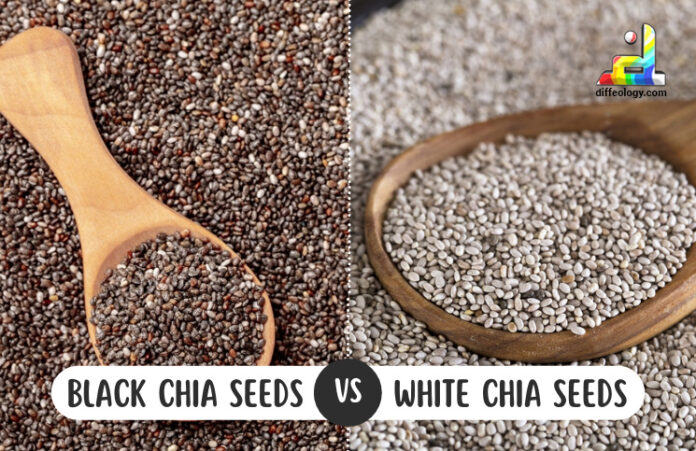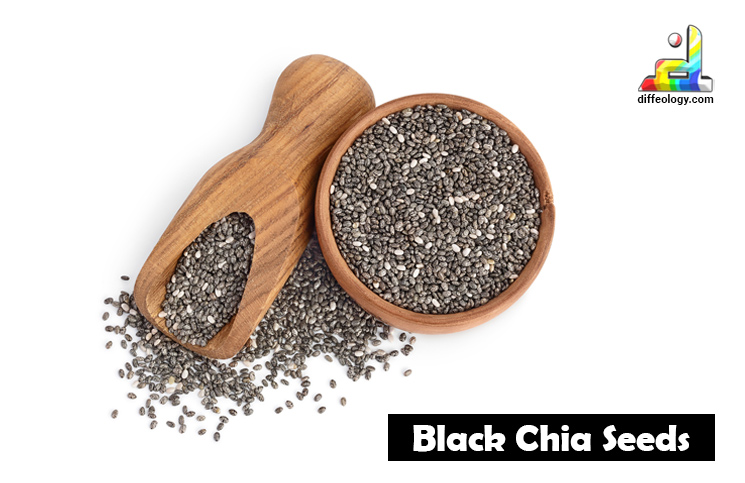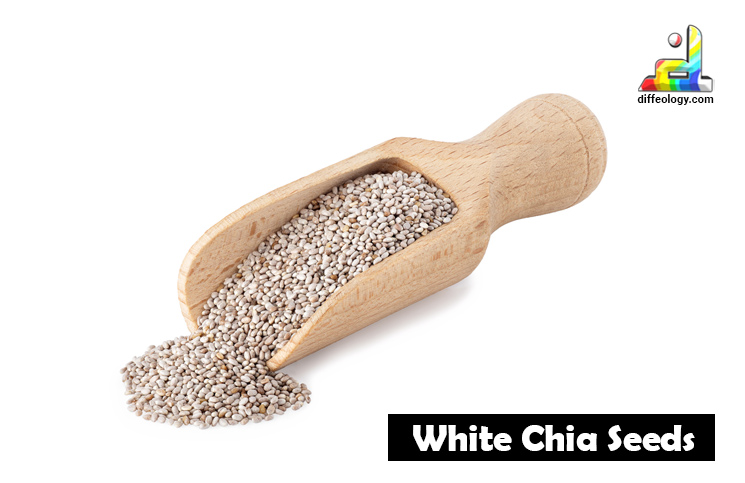Hey there, ever wondered about those tiny seeds that look like they’re straight out of a science fiction movie? Yep, we’re talking about chia seeds! But did you know that there are actually two main types: black chia seeds and white chia seeds? It’s like having two superheroes with similar powers but different costumes! They look similar but actually there is a Difference Between Black and White Chia Seeds. These little seeds might seem small, but they pack a punch when it comes to nutrition and versatility in the kitchen. So, let’s dive into the exciting world of black and white chia seeds and uncover the differences between them!
Main Difference Between Black and White Chia Seeds
Black Chia Seeds are renowned for their rich antioxidant content, black chia seeds are packed with anthocyanins – the same compounds found in blueberries! These antioxidants lend the seeds their characteristic dark color and contribute to their potent health benefits. While white chia seeds may lack the vibrant pigments of their black counterparts, they are no less nutritious. These seeds are a stellar source of protein, fiber, and omega-3 fatty acids, making them a valuable addition to any diet.
Black Chia Seeds Vs. White Chia Seeds
What are Black Chia Seeds?
Black chia seeds are these tiny, dark-colored seeds that come from a plant called Salvia hispanica, which is related to mint. Imagine them like little specks, almost like the seeds you find in a watermelon, but much smaller. These seeds have been around for a super long time, even ancient civilizations like the Aztecs and Mayans used to eat them because they thought they were really healthy.
Read Also: Difference Between Quinoa and Couscous
When you look at black chia seeds, they seem a bit like poppy seeds but smaller. They’re often used in cooking and baking to add a crunchy texture to foods like muffins or bread. Some people even mix them with liquids like water or juice to make this cool, jelly-like substance that you can eat. Plus, they’re packed with good stuff like antioxidants and omega-3 fatty acids, which are good for your body and brain. So, in a nutshell, black chia seeds might be tiny, but they’re pretty mighty when it comes to health and cooking!
What are White Chia Seeds?
White chia seeds are kind of like their black cousins, but they’re lighter in color, almost like tiny pearls. Just like black chia seeds, they come from a plant called Salvia hispanica and are packed with good stuff that’s great for your body. These seeds have been used for a long time by people because they believed they were super healthy, just like black chia seeds.
Read Also: Difference Between Jam and Jelly
When you look at white chia seeds, they’re a bit bigger than the black ones and have this creamy color, sort of like sesame seeds. You can use them in cooking and baking just like the black ones, adding them to things like yogurt or smoothies for a little extra boost of nutrition. Some people also mix them with liquids to make yummy puddings or put them in salads for some added crunch. So, even though they may look a bit different from black chia seeds, white chia seeds are still super cool and good for you!
Comparison Table “Black Chia Seeds Vs. White Chia Seeds”
| Color | Dark | Light |
| Size | Small | Slightly bigger |
| Taste | Nutty | Milder |
| Texture | Firmer | Softer |
| Absorption | Faster | Takes a bit longer |
| Nutritional Content | More antioxidants, Omega-3 fatty acids | Slightly more protein, More calcium |
| Shelf Life | Longer shelf life | May not stay fresh as long |
| Origin | Mainly from Mexico and Central America | Grown in regions like Argentina, Australia |
| Cultivation | Longer history of cultivation | Newer to the market |
| Growing Conditions | More resilient to harsh conditions | Similar growing conditions |
| Culinary Uses | Add visual contrast to dishes | Blend into recipes more seamlessly |
| Seed Size | Smaller | Slightly larger |
| Cooking Texture | Provide crunchier texture | Have a softer texture |
| Color Contrast | Stand out in light-colored dishes | Blend well with pale liquids |
| Price and Availability | Often cheaper | Might be less common in some areas |
Difference Between Black and White Chia Seeds in Detail
Appearance:
Black and white chia seeds may look similar at first glance, but upon closer inspection, you’ll notice their distinct appearances. Black chia seeds are tiny and oval-shaped, with a deep, dark color resembling poppy seeds.
On the other hand, white chia seeds are slightly larger and have a lighter, creamier color, akin to sesame seeds. Imagine black chia seeds as little specks of night sky, while white chia seeds resemble tiny pearls scattered on a plate.
Flavor and Texture:
When it comes to taste and texture, black and white chia seeds have subtle differences. Black chia seeds tend to have a slightly nutty flavor, adding a rich depth to dishes. They also have a firmer texture, providing a satisfying crunch when eaten dry or added to recipes.
In contrast, white chia seeds have a milder taste, almost neutral, making them versatile for various culinary creations. Their texture is softer compared to black chia seeds, almost gel-like when mixed with liquids, which can be appealing to those who prefer smoother textures.
Nutritional Content:
Both black and white chia seeds are packed with nutrition, but their compositions differ slightly. Black chia seeds contain higher levels of antioxidants, which help protect the body from harmful free radicals. They also have more omega-3 fatty acids, essential for heart health and brain function.
On the other hand, white chia seeds boast a slightly higher protein content, making them an excellent choice for those looking to boost their protein intake. Additionally, white chia seeds contain more calcium, contributing to strong bones and teeth. So, depending on your nutritional needs, you might opt for one over the other.
Origin and Cultivation:
The origins and cultivation methods of black and white chia seeds vary, adding to their unique characteristics. Black chia seeds predominantly come from Mexico and Central America, where they have been cultivated for centuries by indigenous communities. Traditionally, they were prized for their medicinal properties and used in various rituals.
White chia seeds, on the other hand, are relatively newer to the market and are often grown in regions like Argentina and Australia. While both varieties require similar growing conditions, including well-drained soil and plenty of sunlight, the specific cultivars and agricultural practices may differ.
Culinary Uses:
In the kitchen, black and white chia seeds can be used interchangeably in many recipes, but their colors may influence their culinary applications. Black chia seeds are often preferred for adding visual contrast to lighter-colored dishes, such as yogurt parfaits or smoothie bowls. Their dark hue can also enhance the appearance of baked goods like muffins or bread.
On the other hand, white chia seeds blend seamlessly into lighter recipes, such as puddings, sauces, or salad dressings, without altering the color significantly. So, when deciding which variety to use, consider the visual impact on your dish.
Availability and Price:
When it comes to availability and price, black and white chia seeds may vary depending on your location and market demand. Generally, black chia seeds are more widely available and tend to be slightly cheaper due to their longer history of cultivation and popularity.
White chia seeds, being a relatively newer variety, might be less common in some areas and could command a slightly higher price point. However, the price difference is often marginal, and both varieties are usually accessible in health food stores, supermarkets, or online retailers.
Cultural Significance:
Beyond their nutritional and culinary differences, black and white chia seeds hold cultural significance in various traditions and communities. In ancient civilizations like the Aztecs and Mayans, chia seeds were revered for their supposed medicinal properties and use in religious ceremonies.
Black chia seeds, in particular, were associated with vitality and strength. Today, chia seeds continue to be celebrated in cultures around the world, both for their health benefits and symbolic meanings. Whether it’s incorporating them into traditional dishes or embracing them as a modern superfood, black and white chia seeds carry a legacy that transcends culinary boundaries.
Absorption Rate:
When it comes to soaking up liquids, black and white chia seeds behave differently. Black chia seeds have a slightly faster absorption rate compared to white ones. This means that when you mix black chia seeds with water or other liquids, they tend to swell up and form a gel-like consistency a bit quicker.
On the other hand, white chia seeds may take a tad longer to absorb liquids fully. So, if you’re in a hurry or need a quick energy boost, black chia seeds might be your best bet.
Shelf Life:
The shelf life of black and white chia seeds can vary due to their differences in oil content and storage conditions. Generally, black chia seeds have a slightly longer shelf life compared to white ones. This is because black chia seeds contain more natural antioxidants, which help prevent them from going rancid as quickly. When stored properly in a cool, dry place in an airtight container, black chia seeds can maintain their freshness for up to two years or even longer.
White chia seeds, while still having a decent shelf life, may not stay fresh quite as long due to their lower antioxidant content. So, if you’re planning to stock up on chia seeds for the long haul, black ones might be the way to go.
Seed Size:
Although both black and white chia seeds are small, they do have discernible differences in size. Black chia seeds are typically a bit smaller compared to white ones. Picture black chia seeds as tiny specks, almost like the dots you see on a ladybug’s back. In contrast, white chia seeds are slightly larger, resembling miniature grains of rice.
While the variation in size might seem minor, it can affect how they’re used in recipes and how they look when sprinkled on top of foods. So, depending on your preference and culinary needs, you might find one size more convenient than the other.
Growing Conditions:
The conditions required to grow black and white chia seeds are quite similar, but there are some nuances to consider. Both varieties thrive in warm climates with plenty of sunlight and well-drained soil. However, black chia seeds are often more resilient to certain environmental factors, such as drought or fluctuations in temperature. This makes them well-suited for regions with harsher growing conditions, like parts of Mexico or Central America.
White chia seeds, while still adaptable, may require slightly more consistent watering and milder temperatures to reach their full potential. So, if you’re thinking of growing chia seeds at home or starting a small garden, it’s essential to consider which variety aligns best with your local climate.
Culinary Texture:
When incorporated into recipes, black and white chia seeds can impart different textures to dishes. Black chia seeds, with their firmer exterior and higher oil content, can add a subtle crunch and richness to foods. Imagine biting into a chewy granola bar with tiny bursts of texture from the black chia seeds scattered throughout.
On the other hand, white chia seeds, while still providing a pleasant crunch, may have a slightly softer texture overall. This can be particularly noticeable when used in recipes like overnight oats or chia seed pudding, where the seeds soften and swell in liquid. So, if you’re looking to experiment with textures in your cooking, the choice between black and white chia seeds can make a difference.
Color Contrast in Recipes:
One fun aspect of using black and white chia seeds in cooking is the visual contrast they can create in dishes. Black chia seeds, with their deep, dark hue, stand out strikingly against lighter-colored ingredients. Picture a creamy yogurt parfait topped with a sprinkling of black chia seeds, resembling a starry night sky.
In contrast, white chia seeds blend seamlessly into pale or translucent liquids, adding a subtle texture without altering the color dramatically. Think of a refreshing glass of lemonade with white chia seeds suspended in it, like tiny pearls dancing in sunlight. So, depending on the aesthetic effect you’re aiming for in your culinary creations, you can choose between black and white chia seeds to enhance the visual appeal of your dishes.
Key Points Showing the Difference Between Black and White Chia Seeds
- Color: Black chia seeds are dark. White chia seeds are light.
- Size: Black chia seeds are small. White chia seeds are a bit bigger.
- Taste: Black chia seeds have a nutty taste. White chia seeds are milder in flavor.
- Texture: Black chia seeds are firmer. White chia seeds are softer.
- Absorption: Black chia seeds absorb liquids faster. White chia seeds take a bit longer to absorb.
- Nutritional Content: Black chia seeds have more antioxidants. White chia seeds contain slightly more protein.
- Shelf Life: Black chia seeds have a longer shelf life. White chia seeds may not stay fresh as long.
- Origin: Black chia seeds mainly come from Mexico and Central America. White chia seeds are grown in regions like Argentina and Australia.
- Cultivation: Black chia seeds have a longer history of cultivation. White chia seeds are newer to the market.
- Growing Conditions: Both need sunlight and well-drained soil. Black chia seeds are more resilient to harsh conditions.
- Culinary Uses: Black chia seeds add visual contrast to dishes. White chia seeds blend into recipes more seamlessly.
- Seed Size: Black chia seeds are smaller. White chia seeds are slightly larger.
- Cooking Texture: Black chia seeds provide a crunchier texture. White chia seeds have a softer texture.
- Color Contrast: Black chia seeds stand out in light-colored dishes. White chia seeds blend well with pale liquids.
- Price and Availability: Black chia seeds are often cheaper. White chia seeds might be less common in some areas.
FAQs: Black Chia Seeds Vs. White Chia Seeds
Conclusion:
And there you have it, folks! The tale of black and white chia seeds, two tiny powerhouses that bring flavor, nutrition, and fun to your plate. Whether you’re sprinkling them on your morning yogurt, blending them into a refreshing smoothie, or using them to thicken up your favorite pudding, these little seeds are here to stay. So, next time you’re at the grocery store, don’t forget to grab a bag of chia seeds easily as you know the Difference Between Black and White Chia Seeds and let your culinary adventures begin!
References & External Links
- Chia Seeds Health Benefits, Nutrients per Serving, Uses, Safety Information, and More



